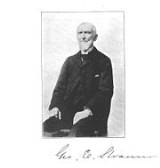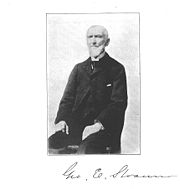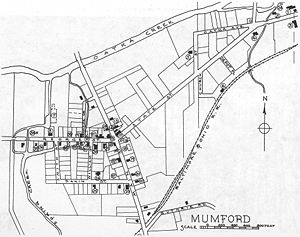
Mumford, New York
Encyclopedia
The hamlet of Mumford lies on the west side of the Town of Wheatland
, south of Oatka Creek
on NY 36 and south of the terminus of NY 383.
 The story of Mumford has been written by several local historians. Carl F Schmidt, an architect
The story of Mumford has been written by several local historians. Carl F Schmidt, an architect
locally noted for his histories of the area, and George Engs Slocum, a local writer whose history of Wheatland appeared in the very early twentieth century. In 1998 (Slocum) and 2002 (Schmidt), the Wheatland Historical Association commissioned reprints of their books.
 Mumford traces its origin directly back to a group of Scottish emigrants who, tiring of English tyranny
Mumford traces its origin directly back to a group of Scottish emigrants who, tiring of English tyranny
, left Perthshire
for the New World, sailing from Greenock
early in March of 1798. Following their arrival in New York on May Day, they traveled to Johnstown
, in Montgomery County
. Johnstown was already home to a number of Scots who had left Scotland in previous years.
A land agent named Charles Williamson, a former Scot working for an English absentee landowner, induced them to settle in the Caledonia
area, then known as Big Springs. His terms appealed to the immigrant Scots, who deputed five of their number to examine the land. Delighted with what they found, countryside not at all unlike their native Scotland, with its southern Highlands and excellent agricultural strath
s, they sealed the deal. The first group of Scotsmen left Johnstown in March of 1799, traveling by sleigh
. In the autumn, the remainder followed.
The Big Springs area was home to the Turtle clan of the Seneca Nation
. The first settlers in Big Springs, two Englishmen named Kane and Moffatt, arrived in 1795 and promptly built a tavern
. Peterson and Fuller soon acquired the tavern, but, when the Scots arrived, the land was still wilderness
. Schmidt described the first of the public works
projects which eventually tamed this wilderness:
At this point, Scottsville
was home to a mere dozen settlers. Francis Albright, the builder of the area's first industrial establishment, Albright's Mill at what would become known as Wheatland Center, arrived in 1799. On Canawaugus Road, Dugan and Schoonover had settled on or near Dugan's Creek. The Scot settlers had no plan to found a village; they were there for the farming. Their farms covered the expanse of land from several miles south of Caledonia, to the east as far as Wheatland Center, and out west along Creek Road. Again, in Schmidt's words:
A group of some thirty Scotsmen comprised the second influx of settlers, in 1803. That year also saw the first schoolhouse west of the Genesee River
, built on a knoll
south of Oatka Creek
and five hundred fifty yards west of the bridge over the creek. John McLaren says of the first teacher, one Alexander McDonald, that he was "the most harsh and tyrannical man ever to wield the birch. By his sanctimonious talk and appearance, he produced the impression upon the minds of the parents that he was imbued with unusual holiness." When the parents realized McDonald's true nature, they invited him to find employment elsewhere, an invitation that did not go unheeded: he went to Canada.
Over the next some years, more people came to the area. They built not only farms but mills for sawing lumber, fulling
, dyeing
, carding
, wool
-making, and grinding flour
, as well as the manufacture of clothing.
does not maintain demographic
data for Mumford.
Notable buildings in Mumford today include the Post office, Library, and local Firehall. The post office now handles Caledonia mail as well due to the closer of Caledonia post office.
contains a model historic village preserving local architecture, a nature center, model gardens, and sporting, art and carriage museums.
Wheatland, New York
Wheatland is a town in Monroe County, New York, United States. The population was 4,775 at the 2010 census. The town is home to Genesee Country Village and Museum.The Town of Wheatland is located in the southwest part of the county....
, south of Oatka Creek
Oatka Creek
Oatka Creek is the third longest tributary of the Genesee River, located entirely in the Western New York region of the U.S. state of New York. From southern Wyoming County, it flows to the Genesee near Scottsville, draining an area of that includes all or part of 23 towns and villages in...
on NY 36 and south of the terminus of NY 383.
History

Architect
An architect is a person trained in the planning, design and oversight of the construction of buildings. To practice architecture means to offer or render services in connection with the design and construction of a building, or group of buildings and the space within the site surrounding the...
locally noted for his histories of the area, and George Engs Slocum, a local writer whose history of Wheatland appeared in the very early twentieth century. In 1998 (Slocum) and 2002 (Schmidt), the Wheatland Historical Association commissioned reprints of their books.
Founding

Wars of the Three Kingdoms
The Wars of the Three Kingdoms formed an intertwined series of conflicts that took place in England, Ireland, and Scotland between 1639 and 1651 after these three countries had come under the "Personal Rule" of the same monarch...
, left Perthshire
Perthshire
Perthshire, officially the County of Perth , is a registration county in central Scotland. It extends from Strathmore in the east, to the Pass of Drumochter in the north, Rannoch Moor and Ben Lui in the west, and Aberfoyle in the south...
for the New World, sailing from Greenock
Greenock
Greenock is a town and administrative centre in the Inverclyde council area in United Kingdom, and a former burgh within the historic county of Renfrewshire, located in the west central Lowlands of Scotland...
early in March of 1798. Following their arrival in New York on May Day, they traveled to Johnstown
Johnstown (city), New York
Johnstown is a city and the county seat of Fulton County in the U.S. state of New York. As of the 2000 Census, the city had population of 8,511. Recent estimates put the figure closer to 8,100. The city was named by its founder, Sir William Johnson after his son John Johnson...
, in Montgomery County
Montgomery County, New York
As of the census of 2000, there were 49,708 people, 20,038 households, and 13,104 families residing in the county. The population density was 123 people per square mile . There were 22,522 housing units at an average density of 56 per square mile...
. Johnstown was already home to a number of Scots who had left Scotland in previous years.
A land agent named Charles Williamson, a former Scot working for an English absentee landowner, induced them to settle in the Caledonia
Caledonia, New York
Caledonia, New York may refer to:*Caledonia , New York, located in Livingston County*Caledonia , New York, located within the Town of Caledonia...
area, then known as Big Springs. His terms appealed to the immigrant Scots, who deputed five of their number to examine the land. Delighted with what they found, countryside not at all unlike their native Scotland, with its southern Highlands and excellent agricultural strath
Strath
A strath is a large valley, typically a river valley that is wide and shallow .An anglicisation of the Gaelic word srath, it is one of many that have been absorbed into common use in the English language...
s, they sealed the deal. The first group of Scotsmen left Johnstown in March of 1799, traveling by sleigh
Sled
A sled, sledge, or sleigh is a land vehicle with a smooth underside or possessing a separate body supported by two or more smooth, relatively narrow, longitudinal runners that travels by sliding across a surface. Most sleds are used on surfaces with low friction, such as snow or ice. In some cases,...
. In the autumn, the remainder followed.
The Big Springs area was home to the Turtle clan of the Seneca Nation
Seneca nation
The Seneca are a group of indigenous people native to North America. They were the nation located farthest to the west within the Six Nations or Iroquois League in New York before the American Revolution. While exact population figures are unknown, approximately 15,000 to 25,000 Seneca live in...
. The first settlers in Big Springs, two Englishmen named Kane and Moffatt, arrived in 1795 and promptly built a tavern
Tavern
A tavern is a place of business where people gather to drink alcoholic beverages and be served food, and in some cases, where travelers receive lodging....
. Peterson and Fuller soon acquired the tavern, but, when the Scots arrived, the land was still wilderness
Wilderness
Wilderness or wildland is a natural environment on Earth that has not been significantly modified by human activity. It may also be defined as: "The most intact, undisturbed wild natural areas left on our planet—those last truly wild places that humans do not control and have not developed with...
. Schmidt described the first of the public works
Public works
Public works are a broad category of projects, financed and constructed by the government, for recreational, employment, and health and safety uses in the greater community...
projects which eventually tamed this wilderness:
At this point, Scottsville
Scottsville, New York
Scottsville is a village in southwestern Monroe County, New York, United States, and is in the northeastern part of the Town of Wheatland. The population was 2,128 at the 2000 census. The village is named after an early settler, Isaac Scott...
was home to a mere dozen settlers. Francis Albright, the builder of the area's first industrial establishment, Albright's Mill at what would become known as Wheatland Center, arrived in 1799. On Canawaugus Road, Dugan and Schoonover had settled on or near Dugan's Creek. The Scot settlers had no plan to found a village; they were there for the farming. Their farms covered the expanse of land from several miles south of Caledonia, to the east as far as Wheatland Center, and out west along Creek Road. Again, in Schmidt's words:
A group of some thirty Scotsmen comprised the second influx of settlers, in 1803. That year also saw the first schoolhouse west of the Genesee River
Genesee River
The Genesee River is a North American river flowing northward through the Twin Tiers of Pennsylvania and New York. The river provided the original power for the Rochester area's 19th century mills and still provides hydroelectric power for downtown Rochester....
, built on a knoll
Hillock
A hillock or knoll is a small hill, usually separated from a larger group of hills such as a range. Hillocks are similar in their distribution and size to small mesas or buttes. The term is largely a British one...
south of Oatka Creek
Oatka Creek
Oatka Creek is the third longest tributary of the Genesee River, located entirely in the Western New York region of the U.S. state of New York. From southern Wyoming County, it flows to the Genesee near Scottsville, draining an area of that includes all or part of 23 towns and villages in...
and five hundred fifty yards west of the bridge over the creek. John McLaren says of the first teacher, one Alexander McDonald, that he was "the most harsh and tyrannical man ever to wield the birch. By his sanctimonious talk and appearance, he produced the impression upon the minds of the parents that he was imbued with unusual holiness." When the parents realized McDonald's true nature, they invited him to find employment elsewhere, an invitation that did not go unheeded: he went to Canada.
Over the next some years, more people came to the area. They built not only farms but mills for sawing lumber, fulling
Fulling
Fulling or tucking or walking is a step in woolen clothmaking which involves the cleansing of cloth to eliminate oils, dirt, and other impurities, and making it thicker. The worker who does the job is a fuller, tucker, or walker...
, dyeing
Dyeing
Dyeing is the process of adding color to textile products like fibers, yarns, and fabrics. Dyeing is normally done in a special solution containing dyes and particular chemical material. After dyeing, dye molecules have uncut Chemical bond with fiber molecules. The temperature and time controlling...
, carding
Carding
Carding is a mechanical process that breaks up locks and unorganised clumps of fibre and then aligns the individual fibres so that they are more or less parallel with each other. The word is derived from the Latin carduus meaning teasel, as dried vegetable teasels were first used to comb the raw wool...
, wool
Wool
Wool is the textile fiber obtained from sheep and certain other animals, including cashmere from goats, mohair from goats, qiviut from muskoxen, vicuña, alpaca, camel from animals in the camel family, and angora from rabbits....
-making, and grinding flour
Flour
Flour is a powder which is made by grinding cereal grains, other seeds or roots . It is the main ingredient of bread, which is a staple food for many cultures, making the availability of adequate supplies of flour a major economic and political issue at various times throughout history...
, as well as the manufacture of clothing.
Today
The US Census BureauUnited States Census Bureau
The United States Census Bureau is the government agency that is responsible for the United States Census. It also gathers other national demographic and economic data...
does not maintain demographic
Demographics
Demographics are the most recent statistical characteristics of a population. These types of data are used widely in sociology , public policy, and marketing. Commonly examined demographics include gender, race, age, disabilities, mobility, home ownership, employment status, and even location...
data for Mumford.
Notable buildings in Mumford today include the Post office, Library, and local Firehall. The post office now handles Caledonia mail as well due to the closer of Caledonia post office.
Culture and recreation
The Genesee Country Village & MuseumGenesee Country Village and Museum
The Genesee Country Village and Museum is a 19th-century living history museum covering more than located in small hamlet of Mumford, New York, about from Rochester, New York, USA. On the museum property is the 19th-century village , the John L...
contains a model historic village preserving local architecture, a nature center, model gardens, and sporting, art and carriage museums.
External links
- http://www.rootsweb.ancestry.com/~nymonroe/vr/wheatland1869.htm - business directory from 1869

